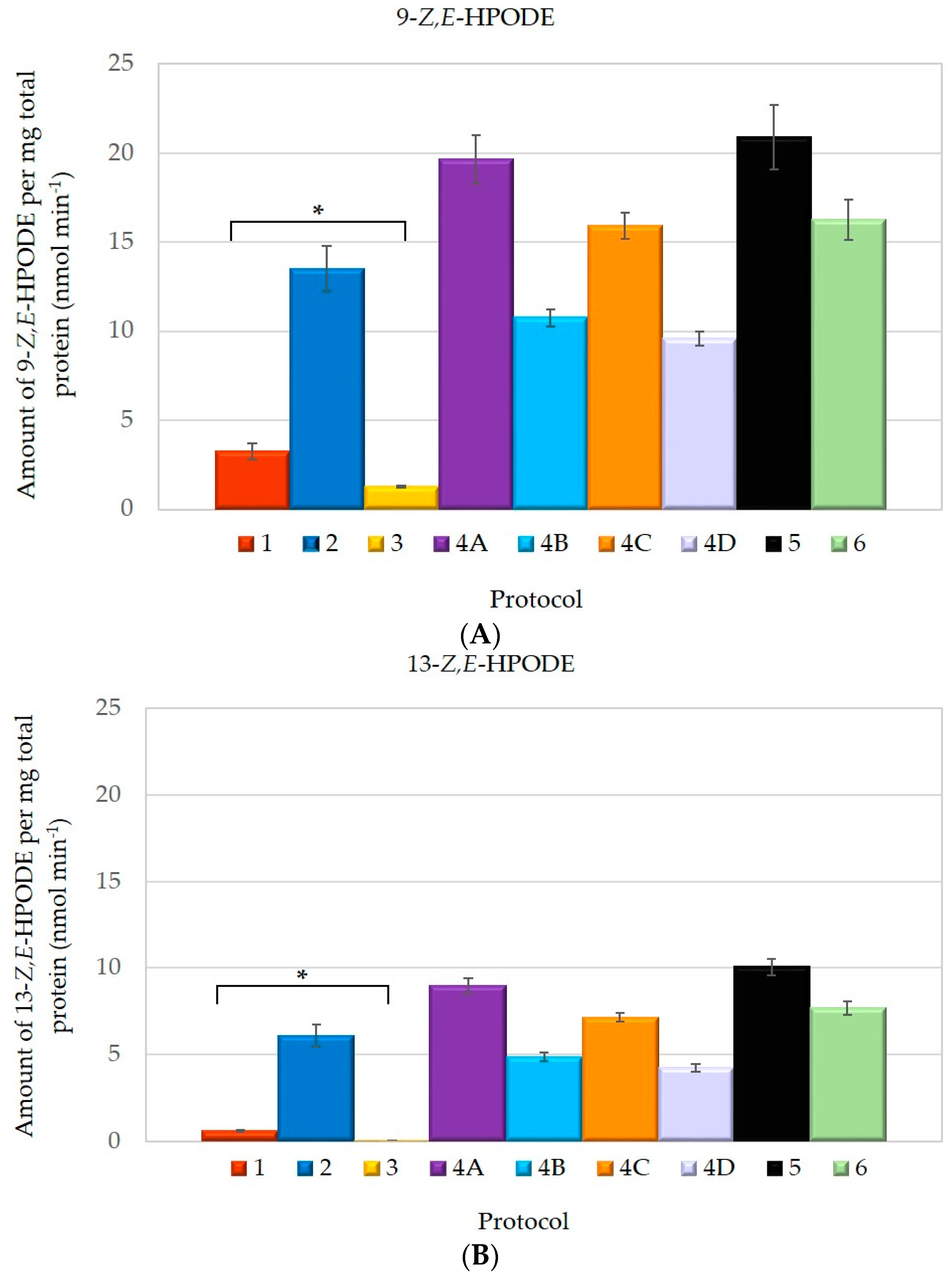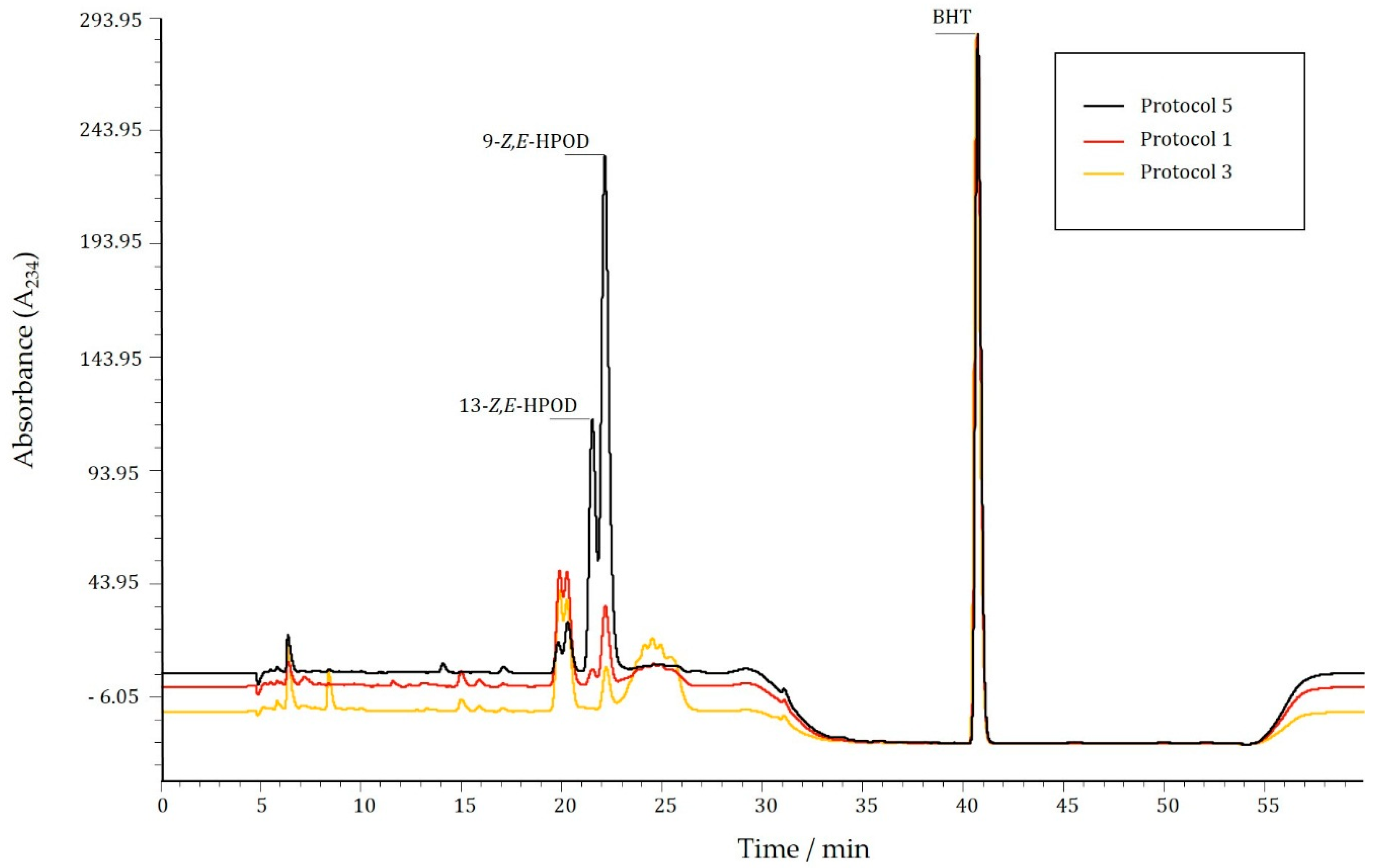Evaluation of Olive Fruit Lipoxygenase Extraction Protocols on 9- and 13-Z,E-HPODE Formation
Abstract
:1. Introduction
2. Results and Discussion
Determination of LOX Activity
3. Materials and Methods
3.1. Materials
3.2. Plant Material
3.3. Protein Extraction Procedures
3.4. Preparation of Linoleic Acid Emulsion
3.5. Determination of LOX Activity
3.5.1. Synthesis and Extraction of Hydroperoxides
3.5.2. RP-HPLC Analysis
3.5.3. Spectrophotometric Analysis
3.6. Statistical Analysis
4. Conclusions
Acknowledgments
Author Contributions
Conflicts of Interest
Abbreviations
| LOX | Lipoxygenase |
| LA | Linoleic acid |
| LnA | Linolenic acid |
| 9-E,Z-HPOD | (±)9-hydroperoxy-10E,12Z-octadecadienoic acid |
| 13-Z,E-HPOD | (±)13-hydroperoxy-9Z,11E-octadecadienoic acid |
| BSA | Bovine serum albumin |
| RP-HPLC | reverse-phase high pressure liquid chromatography |
| PVPP | Polyvinyl polypyrrolidone |
| PMSF | Phenylmethylsulfonyl fluoride |
| HEPES | 4-(2-hydroxyethyl)-1-piperazineethanesulfonic acid |
| MES | 2-(N-morpholino)ethanesulfonic acid |
| BHT | Butylated hydroxytoluene |
| A234 | Absorbance at 234 nm |
References
- López-Miranda, J.; Pérez-Jiménez, F.; Ros, E.; de Caterina, R.; Badimón, L.; Covas, M.I.; Escrich, E.; Ordovás, J.M.; Soriguer, F.; Abiá, R.; et al. Olive oil and health: Summary of the II international conference on olive oil and health consensus report, Jaén and Córdoba (Spain) 2008. Nutr. Metab. Cardiovasc. Dis. 2010, 20, 284–294. [Google Scholar] [CrossRef] [PubMed]
- Kalua, C.M.; Allen, M.S.; Bedgood, D.R.; Bishop, A.G.; Prenzler, P.D.; Robards, K. Olive oil volatile compounds, flavour development and quality: A critical review. Food Chem. 2007, 100, 273–286. [Google Scholar] [CrossRef]
- Porta, H.; Rocha-Sosa, M. Update on Plant Lipoxygenases Plant Lipoxygenases. Physiological and Molecular Features. Plant Physiol. 2002, 130, 15–21. [Google Scholar] [CrossRef] [PubMed]
- Bubola, I.B.; Koprivnjak, K.; Belobrajić, O.S.B. Influence of storage temperature on quality parameters, phenols and volatile compounds of Croatian virgin olive oils. Grasas Aceites 2014, 65. [Google Scholar] [CrossRef]
- Brash, A.R. Lipoxygenases: Occurence, Functions, Catalysis, and Acquisition of Substrate. J. Biol. Chem. 1999, 274, 23679–23683. [Google Scholar] [CrossRef] [PubMed]
- Salas, J.J.; Williams, M.; Harwood, J.L.; Sánchez, J. Lipoxygenase Activity in Olive (Olea europaea) Fruit. J. Am. Oil Chem. Soc. 1999, 76, 1163–1999. [Google Scholar] [CrossRef]
- Kotti, F.; Jaziri, K.; Arab, F.; Mater, Y.; Sifi, S.; Fares, N.; Hammami, M.; Gargouri, M. Lipoxygenase: Optimization of Extraction and Evaluation of its Contribution to Virgin Olive Oil Aroma. Food Biotechnol. 2010, 24, 95–105. [Google Scholar] [CrossRef]
- Gallardo-Guerrero, L.; Jaren-Galan, M.; Hornero-Mendez, D.; Minguez-Mosquera, M.I. Evidence for the involvement of lipoxygenase in the oxidative processes associated with the appearance of green staining alteration in the Gordal olive. J. Sci. Food Agric. 2003, 83, 1487–1492. [Google Scholar] [CrossRef]
- Gregorio, A.; Dugo, G. Lipoxygenase activities in ripening olive fruit tissue. J. Food Biochem. 2000, 24, 417–426. [Google Scholar] [CrossRef]
- Dhifi, W.; Angerosa, F.; Serraiocco, A.; Oumar, I.; Hamrouni, I.; Marzouk, B. Virgin olive oil aroma: Characterization of some Tunisian cultivars. Food Chem. 2005, 93, 697–701. [Google Scholar] [CrossRef]
- Maury, J.; Palmieri-Thiers, C.; de Caraffa, V.B.-B.; Lorenzi, V.; Gambotti, C.; Giannettini, J.; Berti, L. Biochemical and molecular aspects of olive lipoxygenase. In Advances in Olive Resource; Berti, L., Maury, J., Eds.; Transworld Research Network: Kerala, India, 2009. [Google Scholar]
- Ridolfi, M.; Terenziani, S.; Patumi, M.; Fontanazza, G. Characterization of the lipoxygenases in some olive cultivars and determination of their role in volatile compounds formation. J. Agric. Food Chem. 2002, 50, 835–839. [Google Scholar] [CrossRef] [PubMed]
- Luaces, P.; Sanz, C.; Pérez, A.G. Thermal stability of lipoxygenase and hydroperoxide lyase from olive fruit and repercussion on olive oil aroma biosynthesis. J. Agric. Food Chem. 2007, 55, 6309–6313. [Google Scholar] [CrossRef] [PubMed]
- Patui, S.; Braidot, E.; Peresson, C.; Tubaro, F.; Mizzau, M.; Rabiei, Z.; Conte, L.; Macrì, F.; Vianello, A. Lipoxygenase and hydroperoxide lyase activities in two olive varieties from Northern Italy. Eur. J. Lipid Sci. Technol. 2010, 112, 780–790. [Google Scholar] [CrossRef]
- Donaire, J.; Belver, A.; Rodriguez-Garcia, M.; Megias, L. Lipid biosynthesis, oxidative enzyme activities and cellular changes in growing olive fruit. Rev. Esp. Fisiol. 1984, 40, 191–203. [Google Scholar] [PubMed]
- Georgalaki, M.D.; Bachmann, A.; Sotiroudis, T.G.; Xenakis, A.; Porzel, A.; Feussner, I. Characterization of a 13-lipoxygenase from virgin olive oil and oil bodies of olive endosperms. Lipid Fett 1998, 100, 554–560. [Google Scholar] [CrossRef]
- Palmieri-Thiers, C.; Canaan, S.; Brunini, V.; Lorenzi, V.; Tomi, F.; Desseyn, J.-L.; Garscha, U.; Oliw, E.H.; Berti, L.; Maury, J. A lipoxygenase with dual positional specificity is expressed in olives (Olea europaea L.) during ripening. Biochim. Biophys. Acta 2009, 1791, 339–346. [Google Scholar] [CrossRef] [PubMed]
- Charmont, S.; Jamet, E.; Pont-Lezica, R.; Canut, H. Proteomic analysis of secreted proteins from Arabidopsis thaliana seedlings: Improved recovery following removal of phenolic compounds. Phytochemistry 2005, 66, 453–461. [Google Scholar] [CrossRef] [PubMed]
- Kubicka, E.; Jçdrychowski, L.; Amarowicz, R. Effect of phenolic compounds extracted from sunflower seeds on native lipoxygenase activity. Grassas Y Aceties 1999, 50, 127–130. [Google Scholar] [CrossRef]
- Zhang, S.; Zhang, L.-L.; Zhou, K.-K.; Liu, Y.-J.; Zhao, Z. Evaluation of three types of protein extraction methods for tetraploid black locust (Robinia pseudoacacia L.) phloem tissue proteome analysis by two-dimensional electrophoresis. Anal. Methods 2015, 7, 1008–1017. [Google Scholar] [CrossRef]
- Uceda, M.; Frias, L. Trend of the quality and quantitative composition of olive fruit oil during ripening. In Proceedings of the International Meeting on Olive Oil, Cordoba, Spain, 1975; pp. 25–46.
- Bradford, M.M. A rapid and sensitive method for the quantitation of microgram quantities of protein utilizing the principle of protein-dye binding. Anal. Biochem. 1976, 72, 248–254. [Google Scholar] [CrossRef]
- Axelrod, S.; Cheesbrough, B.; Laakso, M. Lipooxygenase from Soybeans. Methods Enzymol. 1981, 71, 441–451. [Google Scholar]
- Sample Availability: Plant samples are available from the authors.


| Reference | Protocol | Fraction | Protein Concentration/μg·mL−1 |
|---|---|---|---|
| [8] | 1 | 1044.40 ± 23.04 | |
| [6] | 2 | 1026.15 ± 37.43 | |
| [7] | 3 | 548.72 ± 20.05 | |
| [14] | 4 | ||
| A | 1508.69 ± 45.01 | ||
| B | 340.12 ± 25.64 | ||
| C | 896.60 ± 5.96 | ||
| D | 248.33 ± 15.45 | ||
| [13] | 5 | 1190.45 ± 50.66 | |
| [12] | 6 | 970.78 ± 37.18 |
| Protocol | 1 | 2 | 3 | 4A | 4B | 4C | 4D | 5 | 6 |
|---|---|---|---|---|---|---|---|---|---|
| 9-/13-Z,E-HPODE | 5.47 | 2.22 | 49.85 | 2.19 | 2.21 | 2.23 | 2.26 | 2.08 | 2.12 |
| RP-HPLC | Spectrophotometry | |||
|---|---|---|---|---|
| Reference | Protocol | Amount of Product Per mg of Total Protein (nmol·min−1) | Amount of Product Per mg of Total Protein (nmol·min−1) | |
| 9-Z,E-HPODE | 13-Z,E-HPODE | |||
| [8] | 1 | 3.23 ± 0.44 * | 0.59 ± 0.04 * | 84.08 ± 1.11 |
| [7] | 3 | 1.29 ± 0.06 * | 0.03 ± 0.003 * | 121.12 ± 3.50 |
| [13] | 5 | 20.89 ± 1.82 | 10.05 ± 0.49 | 37.17 ± 0.56 |
| Protocol | 1 | 2 | 3 | 4 | 5 | 6 |
|---|---|---|---|---|---|---|
| Ref | [8] | [6] | [7] | [14] | [13] | [12] |
| Olive pulp mass (g) | 10 | 10 | 10 | 15 | 10 | 10 |
| Volume of Extraction buffer (mL) | 40 | 50 | 50 | 90 | 40 | 40 |
| Extraction buffer composition | 50 mM Na2PO4 buffer, pH 6.8 | 50 mM HEPES | 50 mM Na2PO4 buffer, pH 6.8 | 50 mM HEPES/KOH, pH 7.5 | 100 mM Na2PO4 buffer, pH 6.7 | 50 mM Na2PO4 buffer, pH 6.8 |
| 0.2 mM EDTA | pH 7.5 | 5 mM EDTA | 5 mM EDTA | 1 mM EDTA | 0.2 mM EDTA | |
| 0.3 mM DTT | 5 mM EDTA | 3 mM DTT | 3 mM DTT | / | 0.3 mM DTT | |
| 1 g PVPP | 3 mM DTT | 1 g PVPP | 4.5 g PVPP | 2 g PVPP | 5 g PVPP | |
| (2% w/v) | 5 g PVPP | (2% w/v) | (5% w/v) | (5% w/v) | (12.5% w/v) | |
| 0.2% Triton X-100 | (10% w/v) | 0.12% Triton X-100 | / | 0.1% Triton X-100 | 0.1% Triton X-100 | |
| / | / | 20 mM KCl | 20 mM KCl | / | / | |
| 10 mM Na2S2O7 | 20 mM KCl | 10 mM Na2S2O7 | / | / | 10 mM Na2S2O7 | |
| / | / | / | 2 mM MgCl2 | / | / | |
| / | 2 mM MgCl2 | / | 7 mM β-ME | / | / | |
| / | 7 mM β-ME | / | 0.1% ascorbate | / | / | |
| / | 0.1% ascorbate | / | 10% glycerol | / | / | |
| / | 10% glycerol | / | / | / | / | |
| / | 330 mM sorbitol | / | 10 mM His | / | / | |
| / | / | / | 0.25 M sucrose | / | / | |
| / | / | / | 0.1 mM PMSF | 0.1 mM PMSF | / | |
| / | / | / | 0.1 mM benzamidine | / | / | |
| / | / | / | 5 mM α-aminocaprioic acid | 5 mM α-aminocaprioic acid | / | |
| Homogenization | 4 cycles, 30 s and 1 min of pause at 4 °C | |||||
| Centrifugation | 10,000× g, 10 min, 4 °C | 40,000× g, 20 min, | 13,000× g, 20 min, | Differential | 27,000× g, 20 min | 27,000× g, 30 min, |
| 4 °C | 4 °C | 4 °C | 4 °C | |||
| Limits of Detection and Quantifiction | 9-Z,E-HPOD | 13-Z,E-HPOD |
|---|---|---|
| LOD | 0.016 | 0.017 |
| LOQ | 0.047 | 0.050 |
© 2016 by the authors. Licensee MDPI, Basel, Switzerland. This article is an open access article distributed under the terms and conditions of the Creative Commons by Attribution (CC-BY) license ( http://creativecommons.org/licenses/by/4.0/).
Share and Cite
Soldo, B.; Šprung, M.; Mušac, G.; Pavela-Vrančić, M.; Ljubenkov, I. Evaluation of Olive Fruit Lipoxygenase Extraction Protocols on 9- and 13-Z,E-HPODE Formation. Molecules 2016, 21, 506. https://doi.org/10.3390/molecules21040506
Soldo B, Šprung M, Mušac G, Pavela-Vrančić M, Ljubenkov I. Evaluation of Olive Fruit Lipoxygenase Extraction Protocols on 9- and 13-Z,E-HPODE Formation. Molecules. 2016; 21(4):506. https://doi.org/10.3390/molecules21040506
Chicago/Turabian StyleSoldo, Barbara, Matilda Šprung, Gloria Mušac, Maja Pavela-Vrančić, and Ivica Ljubenkov. 2016. "Evaluation of Olive Fruit Lipoxygenase Extraction Protocols on 9- and 13-Z,E-HPODE Formation" Molecules 21, no. 4: 506. https://doi.org/10.3390/molecules21040506
APA StyleSoldo, B., Šprung, M., Mušac, G., Pavela-Vrančić, M., & Ljubenkov, I. (2016). Evaluation of Olive Fruit Lipoxygenase Extraction Protocols on 9- and 13-Z,E-HPODE Formation. Molecules, 21(4), 506. https://doi.org/10.3390/molecules21040506






